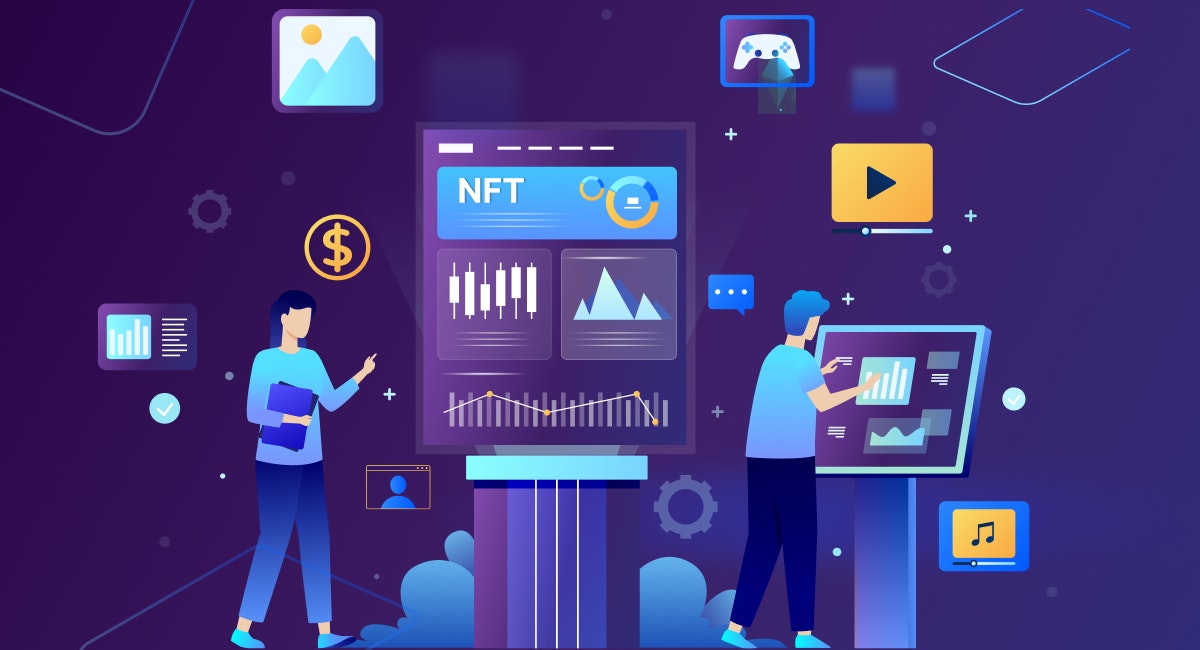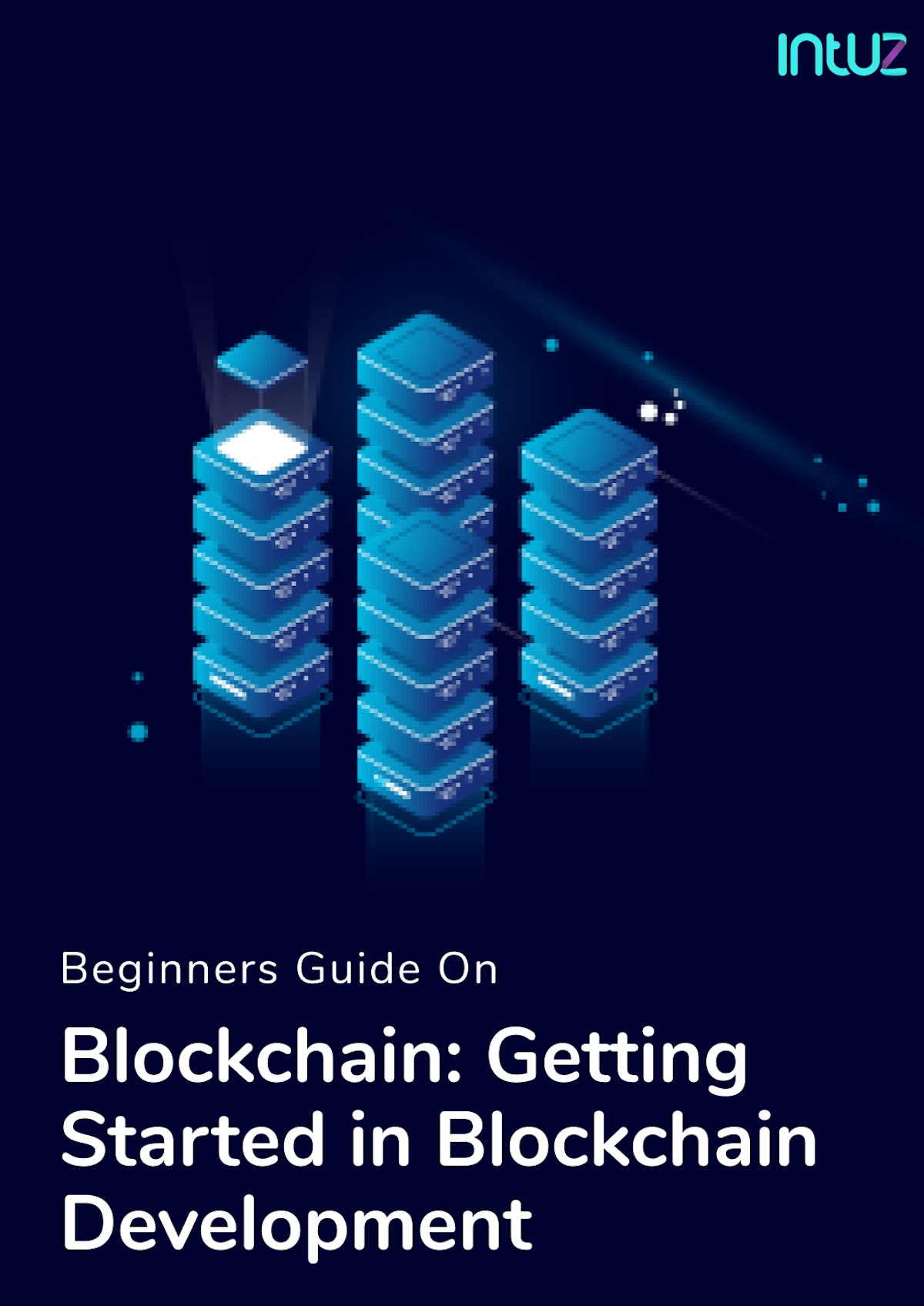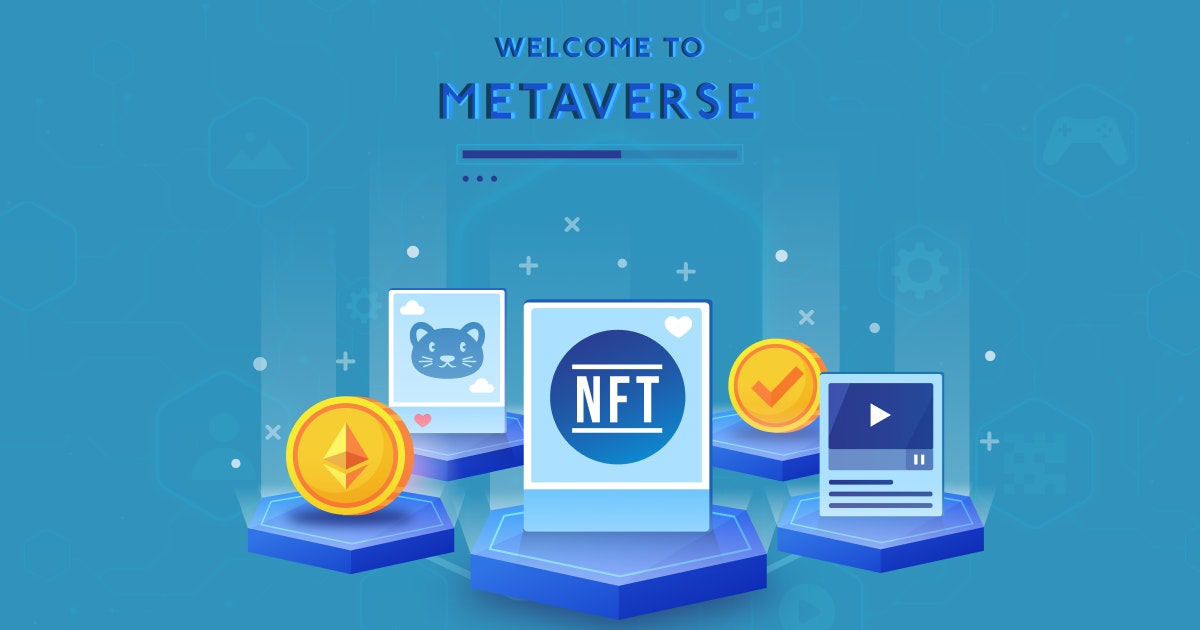Table of Content
Non-Fungible Tokens (NFTs) are digital assets that have gained significant attention and popularity in recent years. Unlike cryptocurrencies such as Bitcoin or Ethereum, which are fungible and can be exchanged one-to-one, NFTs are unique and cannot be exchanged.
Each NFT has distinct characteristics and properties that set it apart from others, making it an individual and one-of-a-kind item in the digital realm. Research shows that the NFT market will be worth $3,162M by 2027, with several reasons fueling its growth and popularity:
- First, NFTs provide a means for creators to monetize their digital creations directly without the need for intermediaries such as galleries or auction houses. This has opened up new opportunities for artists, musicians, and other content creators to sell their work and reach a global audience.
- Second, NFTs represent ownership or proof of authenticity of a particular digital item or asset, including artwork, music, videos, collectibles, virtual real estate, and more. These assets are typically created on blockchain platforms, with Ethereum being the most widely used blockchain for NFTs.
- Third, the rising interest from celebrities, athletes, and influential figures has brought NFTs into the mainstream spotlight, resulting in many famous influencer marketing campaigns and collaborations.
What is an NFT Marketplace?
An NFT marketplace serves as a typical online shopping platform where creators can showcase and sell their digital collectibles, artworks, virtual real estate, in-game items, and more, and buyers can interact with them, negotiate prices, and complete transactions securely. The top players in the NFT marketplace landscape are the following:
- OpenSea is a leading NFT marketplace on Ethereum, supporting a variety of digital assets with a user-friendly interface.
- Rarible, also on Ethereum, allows users to easily create and sell NFTs, utilizing decentralized governance.
- SuperRare emphasizes scarcity and quality in digital art NFTs, supporting artist royalties.
- AtomicHub offers a comprehensive platform for trading NFTs from games, virtual worlds, and collectibles.
- Binance NFT operates on the Binance Smart Chain and Ethereum, offering exclusive drops, auctions, and staking rewards.
- NBA Top Shot offers NBA-licensed digital collectibles, with limited edition drops and tiered collectibles appealing to basketball fans.
If you plan to build and launch an NFT marketplace for enabling the creation, buying, selling, and auctioning of NFTs, it is easy to get overwhelmed by the specifics and potential pitfalls of managing it all. In this guide, we cover all aspects you must know in your NFT marketplace development process and elaborate on the components that make it a success:
The ultimate use case of NFT wallets: Managing and storing digital assets
An NFT wallet is a digital wallet designed to provide a secure way to store, receive, send, and manage NFT collections. Each wallet has a unique address, similar to a cryptocurrency wallet, used for receiving NFTs from others.
Types of NFT Wallets
It is important to note that some wallets support multiple Blockchain networks. In contrast, others are specific to a particular Blockchain or NFT standard, such as Ethereum-based wallets for ERC-721 and ERC-1155 tokens. Here are the top NFT wallets one should know about:
Marketplace Solution Connecting Buyers and Sellers for Physical Goods - Case Study
Explore Now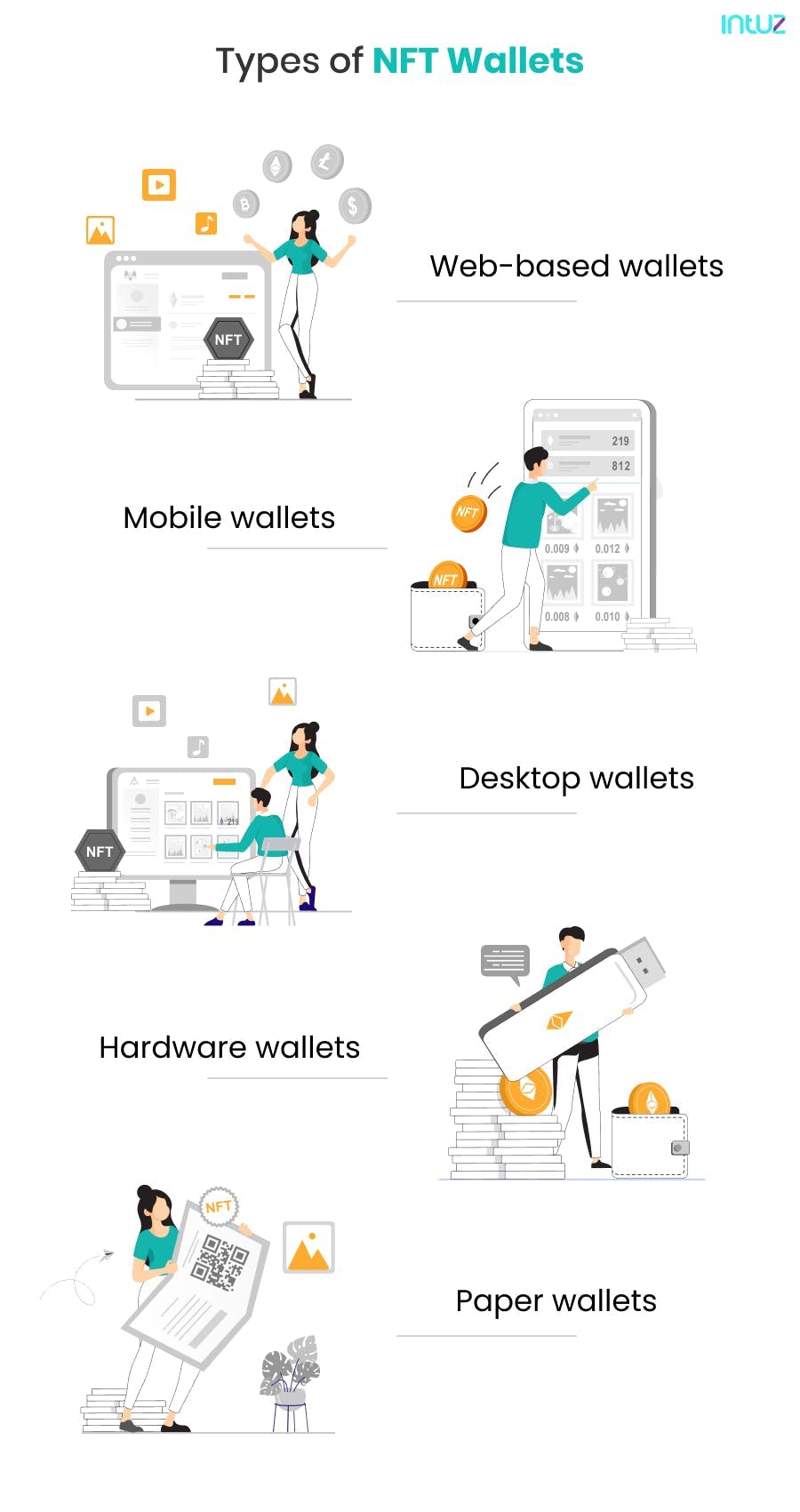
1. Web-based wallets
These wallets are accessible through web browsers, allowing users to interact with NFTs using a user-friendly interface. They often integrate with popular NFT marketplaces, ensuring ease in buying, selling, and trading NFTs. Examples include MetaMask and MyEtherWallet.
2. Mobile wallets
These are built for smartphones and offer the convenience of managing NFTs on the go. They typically provide a user-friendly interface and can be easily connected to NFT marketplaces. Examples of mobile wallets include Rainbow Wallet and Coinbase Wallet.
3. Desktop wallets
These are software applications installed on computers or laptops. They provide a secure environment for managing NFTs and can be integrated with various Blockchain networks. Desktop wallets often offer advanced features like multi-signature support and hardware wallet integration. Some popular desktop wallets for NFTs are Atomic Wallet and Exodus.
4. Hardware wallets
These physical devices store NFTs offline, providing an extra layer of security. They are often considered the most secure option for storing cryptocurrencies and NFTs. Hardware wallets store private keys offline, protecting them from online threats. Examples of hardware wallets are Ledger Nano S, Ledger Nano X, and Trezor.
5. Paper wallets
These involve generating a physical copy of your NFT’s private key or seed phrase on a piece of paper. This method provides a cold storage solution, keeping the keys offline. However, it requires extra precautions to safeguard against physical damage or loss. Users can create paper wallets using offline tools or dedicated paper wallet generators such as WalletGenerator.net.
How to set up and secure an NFT wallet
To create an NFT wallet and ensure the safety and protection of your digital assets, follow these general steps:
1. Research and choose a wallet: Consider factors such as ease of use, compatibility with the NFT platforms you plan to use, and the ability to control your private keys.
2. Download and install the wallet software: During the setup, choose a username and password and fix a private key and recovery phrase for restoring your wallet if you lose access.
3. Secure the wallet: Enable all available security measures, such as two-factor authentication (2FA) or biometric authentication, using an authenticator app or hardware security key.
4. Connect to the appropriate network: In most wallets, you can choose the desired network from a list of options available.
5. Fund your wallet: You can acquire cryptocurrency by purchasing it from a cryptocurrency exchange and transferring it to your wallet’s address.
NFT wallet security best practices
Remember, doing your research and exercising caution when participating in the NFT space is important. Be mindful of potential scams, high gas fees during times of network congestion, and the environmental impact of certain Blockchains. Here are some tips for enhancing the security of your NFT wallets:
- Create a strong and unique password for your wallet. Use upper and lower case letters, numbers, and special characters. Avoid using common phrases or personal information that can be easily guessed.
- Regularly update your wallet software and applications to benefit from the latest security patches and bug fixes. Outdated software may contain vulnerabilities that hackers can exploit.
- Consider using a hardware wallet, a physical device to securely store your private keys offline. It provides an additional layer of protection against online threats and malware.
- Make regular backups of your wallet and store them securely offline, such as on encrypted external storage devices or paper wallets. This way, even if your device is lost or compromised, you can restore your wallet and access your NFTs.
- Be vigilant against phishing attempts, where attackers trick you into revealing your wallet credentials or private keys through fake websites or emails. Always verify the authenticity of the websites and communication channels you use.
- Be cautious when accessing your wallet over public WiFi networks or unsecured internet connections. Use a VPN to encrypt your internet traffic and protect your wallet’s privacy.
- Before sending or receiving NFTs, double-check the wallet addresses to ensure accuracy. A small mistake in an address can lead to the permanent loss of your assets. Avoid clicking on suspicious links or sharing your wallet information with untrusted sources.
Showcasing NFTs on the marketplace: Mint, list, and trade your digital collectibles
NFTs are unique digital assets representing ownership or proof of authenticity for various digital or physical items. Several mechanics are involved in buying, selling, and trading these digital assets, including:
Minting NFTs
Minting NFTs involves generating distinctive digital assets, representing a range of artistic and creative endeavors, and storing them on a blockchain network.

- The process begins with creating artwork using software like Photoshop or GIMP and saving it as a JPEG or PNG file.
- The next step is to manage the NFT data asset by creating a file containing all the necessary data for your NFT.
- Once prepared, the artwork and data are uploaded onto a suitable blockchain platform, such as Ethereum or Binance Smart Chain, where the NFT contract is programmed.
Upon completion, the unique NFT becomes viewable in your wallet and publicly accessible on the marketplace.
Listing NFTs
Listing NFTs involves choosing an NFT marketplace like SuperRare or Rarible, and preparing metadata that includes a captivating title, detailed description, and high-quality images or videos, all aimed at drawing potential buyers’ attention. In addition:

- Select relevant categories and tags for better discoverability.
- When it comes to pricing, sellers can set a fixed price, start an auction-style sale, set a reserve price, or provide a “Buy Now” option for immediate purchase.
- Once all the information is filled in, the NFT is listed on the marketplace, ready to attract bids and inquiries.
Monitoring performance and adjusting pricing options as needed ensures the listing stays competitive and appealing.
Trading NFTs
Trading NFTs refers to the purchase, sale, and bidding of unique digital assets. This process begins with exploring the NFT marketplace, using filters, categories, or highlighted listings to discover intriguing NFTs.

- Once an NFT has been selected based on preferences like artwork, creator, and price, the availability of the asset needs to be confirmed.
- Purchase options could include a “Buy Now” button for fixed-price NFTs or a bidding process for auctioned NFTs.
- Marketplaces usually accept cryptocurrency payments, necessitating the connection of your wallet and transaction confirmation.
Bidding on NFTs
Bidding on NFTs involves participating in auctions for desirable digital assets. It requires a keen understanding of auction details like the starting bid, duration, and any seller-set reserve prices. A strategic approach to bidding is crucial, with bids placed through a connected wallet.

- Notifications throughout the auction will alert bidders if they have been outbid, offering a chance to up the ante or retreat.
- Upon the auction's conclusion, the highest bidder secures the NFT.
- Winning bidders must then follow marketplace instructions to finalize the purchase.
The NFT pricing model: Royalties and revenue sharing
NFTs can be priced in three ways:

- The first, fixed price sales, provide a set cost for buyers, simplifying the purchase process without any bidding involved.
- The second model involves auctions, where sellers set a starting bid, and interested buyers place competing bids within a specified timeframe The highest bidder at the close of the auction secures the NFT.
- Lastly, some NFT marketplaces facilitate private negotiations. Here, buyers submit offers at a specific price, with sellers able to accept, reject, or counter these offers. This process continues until a mutually agreeable price is reached.
Here is how the NFT royalties and revenue sharing work:
NFT royalties and revenue sharing are facilitated by smart contracts, which ensure artists receive a designated percentage from initial and secondary sales, typically ranging between 2% and 10%. Any additional income generated by the NFT, like licensing deals or merchandise sales, is also distributed among relevant stakeholders, ensuring fair revenue sharing with NFTs.
Key Applications of NFT Marketplaces
While some use cases of NFTs have gained significant traction and attention, others are still emerging. Here is an elaboration on the well-known and up-and-coming applications of NFT marketplaces:
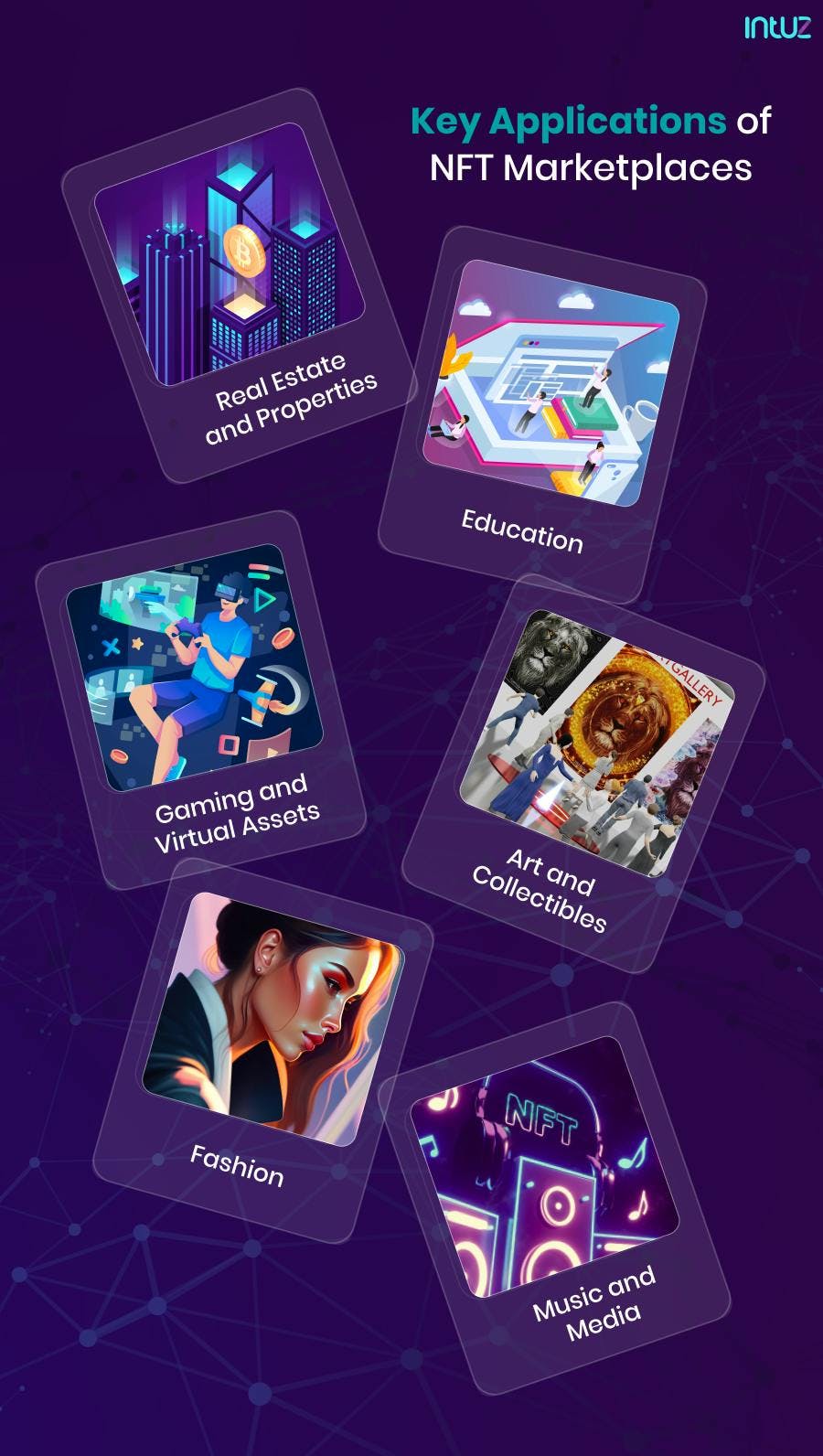
1. Real estate and properties
NFTs revolutionize the real estate industry by tokenizing properties, representing real-world assets, such as buildings, land, or even individual units within a property, as NFTs. Doing so can divide these assets into fractional ownership, enabling investors to buy and sell property shares.
2. Gaming and virtual assets
NFTs have gained significant traction in the gaming industry. They can represent in-game items, such as weapons, skins, and virtual currencies, as unique tokens. Players can buy, sell, and trade these items on NFT marketplaces, allowing them to own and control their digital assets. NFTs can also tokenize virtual land, enabling players to own and develop virtual properties within games or virtual reality environments.
3. Art and collectibles
NFTs have profoundly impacted the art market, enabling artists to create and sell digital artwork as unique tokens. NFTs provide proof of ownership and authenticity, ensuring the scarcity and provenance of digital art. Artists can tokenize their creations, sell them directly to collectors, and receive royalties when their art is resold.
4. Music and media
NFTs have disrupted the entertainment industry, particularly in music and digital media. Musicians and artists can tokenize their music, albums, and merchandise, allowing fans to purchase and own unique digital collectibles associated with their favorite artists. NFTs can also be used to sell concert tickets, granting access to exclusive events or experiences.
5. Education
Educators and content creators can tokenize their eBooks, online courses, tutorials, and other educational resources, allowing students and learners to purchase and access them. NFTs provide a way to ensure the authenticity and ownership of digital educational content, and they can also enable educators to offer limited editions, exclusive content, or additional perks to those who acquire their NFT-based educational materials.
6. Fashion
Fashion designers can tokenize their clothing, accessories, and digital fashion items into unique and collectible assets. These assets can be bought, sold, and traded on NFT marketplaces, allowing fashion enthusiasts to virtually own and showcase exclusive pieces.
Planning and considerations for NFT marketplace creation
1. Research
This process entails gaining insights into market trends, understanding your target audience, and analyzing competitors.
- By conducting comprehensive research, you can acquire valuable information about the types of NFTs in demand, user expectations for features, and strategies for differentiating your marketplace. These insights will enable you to make informed decisions during the development and marketing stages.
- A real-life example demonstrating the importance of research is NBA Top Shot, an NFT marketplace that gained immense popularity in 2021. The creators of NBA Top Shot analyzed market trends and recognized the high demand for digital basketball highlights. They identified their target audience - basketball fans and collectors. As a result, NBA Top Shot became a resounding success, attracting millions of users to their platform.
2. Craft a robust business model
This is vital to the prosperity of an NFT marketplace. It includes identifying revenue streams, such as transaction fees or subscriptions, while considering commission fees for NFT sales and royalties for secondary market transactions.
By thoughtfully addressing these elements, you can ensure the financial viability of your marketplace and deliver value to creators and buyers alike. A compelling real-life example is OpenSea, one of the leading NFT marketplaces.
They have implemented a commission-based revenue model, charging a transaction fee for every NFT sale conducted on their platform. This approach has proven successful, generating a consistent income stream for the platform.
3. Meet legal and regulatory compliance
Respecting intellectual property rights is crucial when creating and trading NFTs. NFTs can represent various forms of digital content, including artwork, music, videos, and more. Here is how to always meet compliance:
Obtain the necessary licenses or permissions before creating NFTs based on others' intellectual property.
Comply with copyright laws and recognize creators’ moral rights.
Be mindful of anti-money laundering (AML) and Know Your Customer (KYC) regulations.
Some NFTs might be considered securities or investment contracts, subject to specific regulations.
Understand the tax obligations associated with NFTs, as these vary across jurisdictions.
Consult legal experts to navigate the complexities and establish a secure, compliant platform.
4. Implement marketing and branding strategies
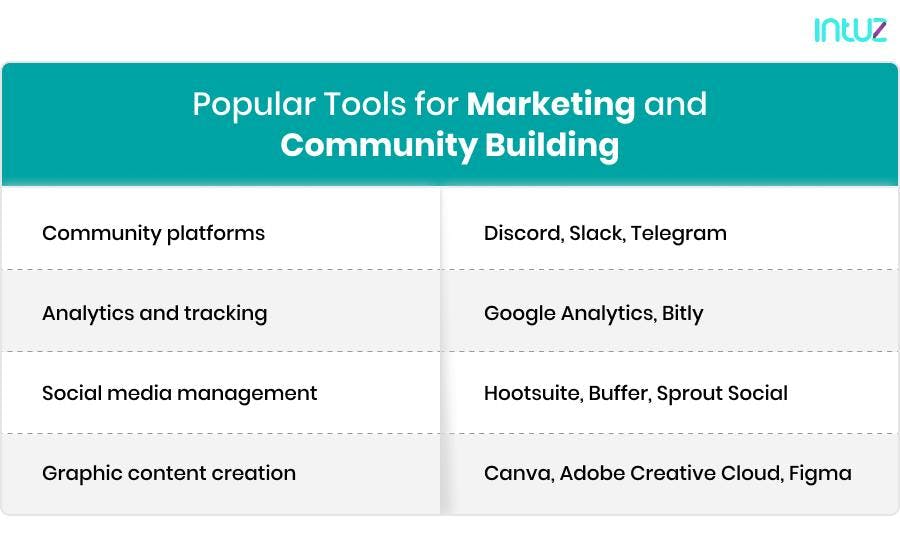
To maximize the visibility and sales potential of your NFT marketplace, you must do the following:
- Actively utilize social media platforms, forums, art communities, and your personal network to disseminate information about it. Engage with potential buyers by promptly addressing their inquiries and providing regular updates to generate interest.
- Prioritize community-building efforts to foster engagement and loyalty among users.
undefinedundefined - Develop high-quality and engaging content to educate and entertain the community. This can include blog posts, videos, tutorials, interviews, or behind-the-scenes content about artists and their creative process. Platforms like Medium, YouTube, and Substack can be used for content distribution.
- Organize virtual events, such as live auctions, virtual exhibitions, or AMA (Ask Me Anything) sessions with artists or industry experts. Hold contests for the best NFT collections or artwork, offering incentives like exclusive NFTs, discounts, or collaborations with renowned artists
Important factors in NFT marketplace development
For such a marketplace to succeed and provide a reliable and satisfactory platform for users to engage in NFT transactions, the following attributes take precedence:
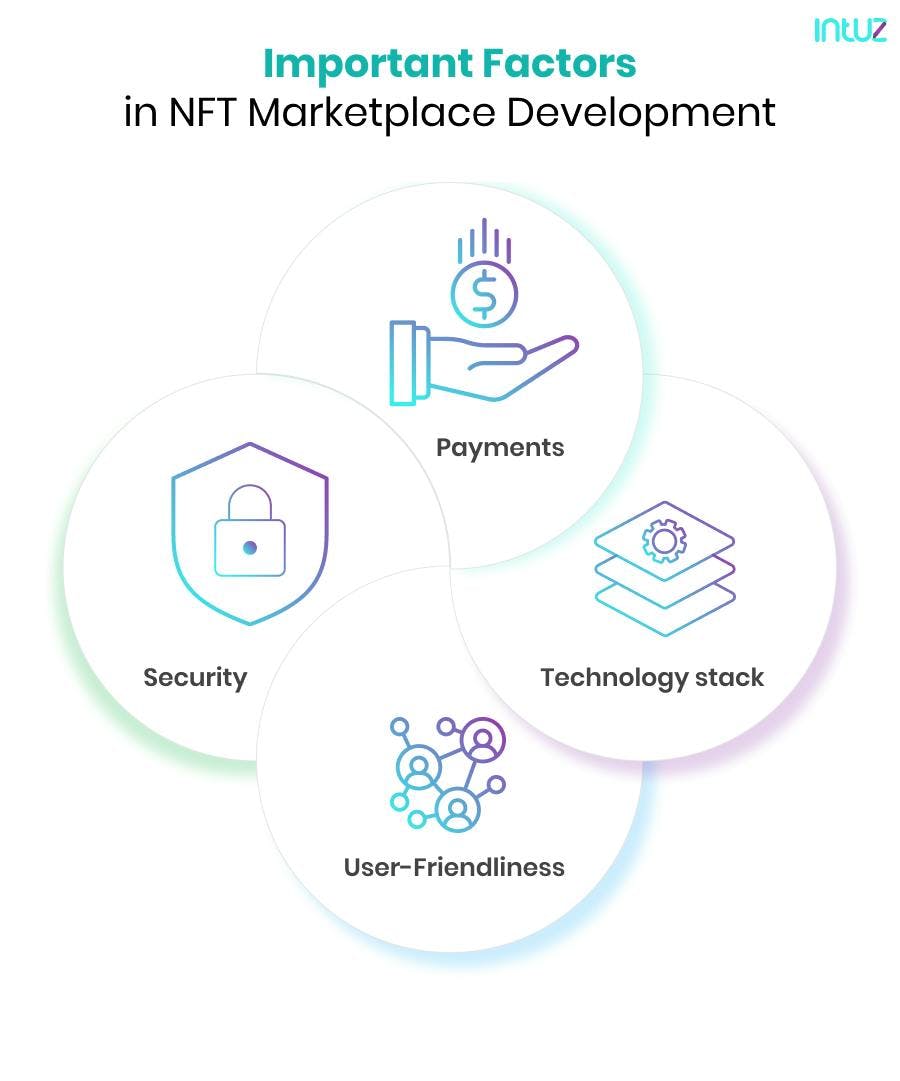
1. Payments
Incorporating secure payment gateways facilitates smooth and secure transactions on an NFT marketplace. Users should be able to purchase, sell, and bid on NFTs using various payment methods, including both cryptocurrencies and fiat currencies.
When implementing secure payment gateways, commonly employed tools include well-established systems such as Stripe and PayPal, which enable smooth and secure transactions, ensuring user confidence during the payment process.
Additionally, cryptocurrency wallets, such as MetaMask, facilitate the seamless processing of cryptocurrency payments. Blockchain explorers, such as Etherscan, can also be utilized to verify and track transaction details.
2. Security
Implementing robust security measures is imperative for safeguarding users’ assets in the marketplace. One vital aspect involves utilizing secure wallets, which serve as digital storage solutions for NFT transactions.
These wallets must incorporate powerful encryption techniques and adhere to industry best practices to effectively protect users’ private keys. Plus, conducting smart contract audits is essential for detecting and rectifying any vulnerabilities in the marketplace’s underlying code, thereby mitigating the risk of potential exploits or hacking incidents.
3. Technology stack
Selecting the appropriate technology stack is paramount when developing an NFT marketplace. You must, therefore, make informed choices regarding Blockchain, such as Ethereum, Binance Smart Chain, or Flow, that can accommodate NFT standards like ERC-721 or ERC-1155.
Furthermore, consideration must be given to the smart contract language, such as Solidity or Cadence, as well as decentralized storage solutions like IPFS (InterPlanetary File System) for the storage of NFT metadata and assets.
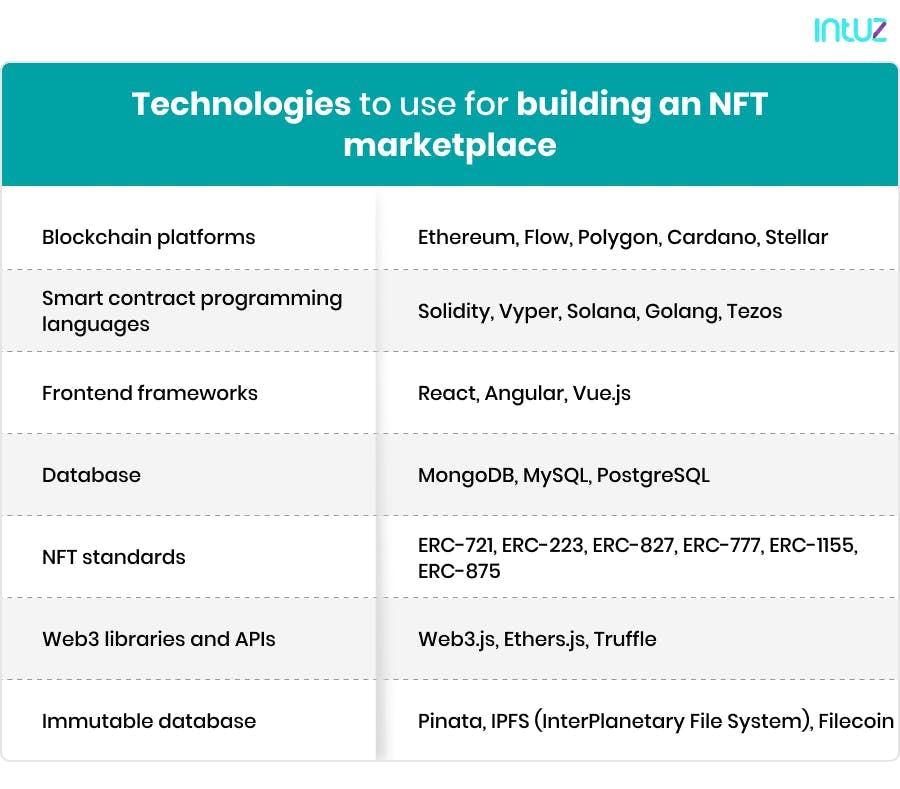
4. User-friendliness
Your NFT marketplace should prioritize a superior UI/UX to enhance user satisfaction through effortless navigation and platform interaction. Here is how:
- Search and filtering options, clear categorization, and effortless navigation should be incorporated, all contributing to a positive user experience.
- Interactive features like bidding, auctions, and offer management can enhance user engagement.
- Regarding tools, industry-standard software such as Figma, Sketch, and Adobe XD are commonly employed for UI/UX design.
The importance of secure storage for NFTs
Ensuring the safety of NFTs is crucial, given their monetary value and potential sentimental significance. It is essential to protect NFTs from malicious forces, especially if they are considered investments. Here is how storage can save the day:
1. Data integrity
Secure storage ensures the integrity of NFT data. Any alteration, modification, or corruption of the NFT files can compromise their value and authenticity. By employing robust security measures, such as encryption and decentralized storage, the data integrity of NFTs can be preserved, guaranteeing that the assets remain unchanged and reliable.
2. Asset protection
NFTs represent unique digital assets that often hold significant value, whether artwork, collectibles, virtual real estate, or other digital creations. Secure storage ensures the integrity and protection of these assets, safeguarding them from unauthorized access, tampering, or theft. Such systems incorporate various measures like encryption, access controls, and monitoring, to protect against hacking attempts and data breaches.
3. Ownership verification
NFTs serve as proof of ownership or authenticity for a particular digital asset. By securely storing NFTs, the ownership and authenticity of these assets can be reliably verified. It ensures that the rightful owner can demonstrate ownership without disputes or fraudulent claims.

4. Long-term preservation
Some NFTs hold historical, cultural, or artistic significance and are intended for long-term preservation. Secure storage ensures the longevity of these assets by protecting them from data degradation, loss, or obsolescence. By employing robust backup and archival strategies, it is possible to maintain the long-term value and accessibility of NFTs.
5. User trust and confidence
When individuals know that their valuable assets are stored securely, they are more likely to participate in NFT transactions, invest in digital assets, and contribute to the growth of the NFT marketplace.
What role does IPFS play in the NFT marketplace?
The InterPlanetary File System (IPFS) is a decentralized and distributed file system designed to provide efficient and secure storage and retrieval of files on the internet. It is an open-source protocol aiming to create a global peer-to-peer network, enabling users to store and share data.
With IPFS, NFTs can be stored in a decentralized manner, eliminating the reliance on a single server or Blockchain. Each NFT can be represented as a file, and its content can be stored and distributed across the IPFS network. The unique hash of the NFT file serves as its identifier, ensuring its integrity and availability, as explained before.
By leveraging IPFS for NFT storage, several benefits can be realized:
- It enhances the availability of NFTs as they are replicated and distributed across multiple nodes. This reduces the risk of a single point of failure or data loss.
- It increases data transfer speeds since files can be fetched from the nearest available node, improving the user experience.
- It promotes censorship resistance, as censoring or removing files stored in a distributed network is challenging.
To access an NFT stored on IPFS, users can retrieve the file using its unique content identifier or a decentralized naming system, such as the InterPlanetary Naming System (IPNS). IPNS provides a mutable mapping between human-readable names and IPFS content addresses, allowing users to associate a name with an NFT’s content address.
Best practices for IPFS storage in an NFT marketplace
- Encrypt the NFT metadata and associated files before storing them on IPFS. This ensures that only authorized parties can access and decrypt the data. Utilize strong encryption algorithms and secure key management practices to protect the encryption keys.
- Implement access controls to restrict who can upload, modify, or delete NFTs in the marketplace. Use authentication mechanisms such as OAuth, JWT (JSON Web Tokens), or similar protocols to verify the identity of users. Define granular access control policies based on user roles or permissions to ensure that only authorized individuals can perform specific actions.
- Maintaining an auditable log of actions like uploads, modifications, and deletions on NFTs, along with user data and timestamps, enhances security. Ensure these logs are tamper-proof. Regularly upgrade to the latest stable version of IPFS for bug fixes and security patches. Using IPFS Private Networks (IPFS-PRIVNET) can boost privacy and security, allowing a trusted network of nodes for NFT handling.
- Have a robust backup and disaster recovery strategy to protect against data loss or system failures. Regularly back up the NFT metadata and associated files stored on IPFS to separate, secure storage systems. Test the restoration process periodically to ensure backups are reliable and can be used to recover data when needed.
Making “search and discovery” a breeze in the NFT marketplace
To streamline “search and discovery” in the NFT marketplace, tools like search filters, sorting options, metadata indexing, artist profiles, and advanced search can help users locate specific NFTs or artists. Search results can be refined by price, category, rarity, or other criteria, and users can explore artist profiles to discover new or preferred creators.
Using algorithms and ML, the marketplace can analyze user interactions and behavior to offer personalized NFT recommendations, enhancing user experience and facilitating the discovery of relevant NFTs that align with their interests.
How to create an NFT marketplace
Building an NFT marketplace is a complex undertaking that requires careful consideration and effort. Unlike setting up an Etsy shop or a Shopify account, it involves additional complexities. However, the rewards can be significant. Here is what you need to do:
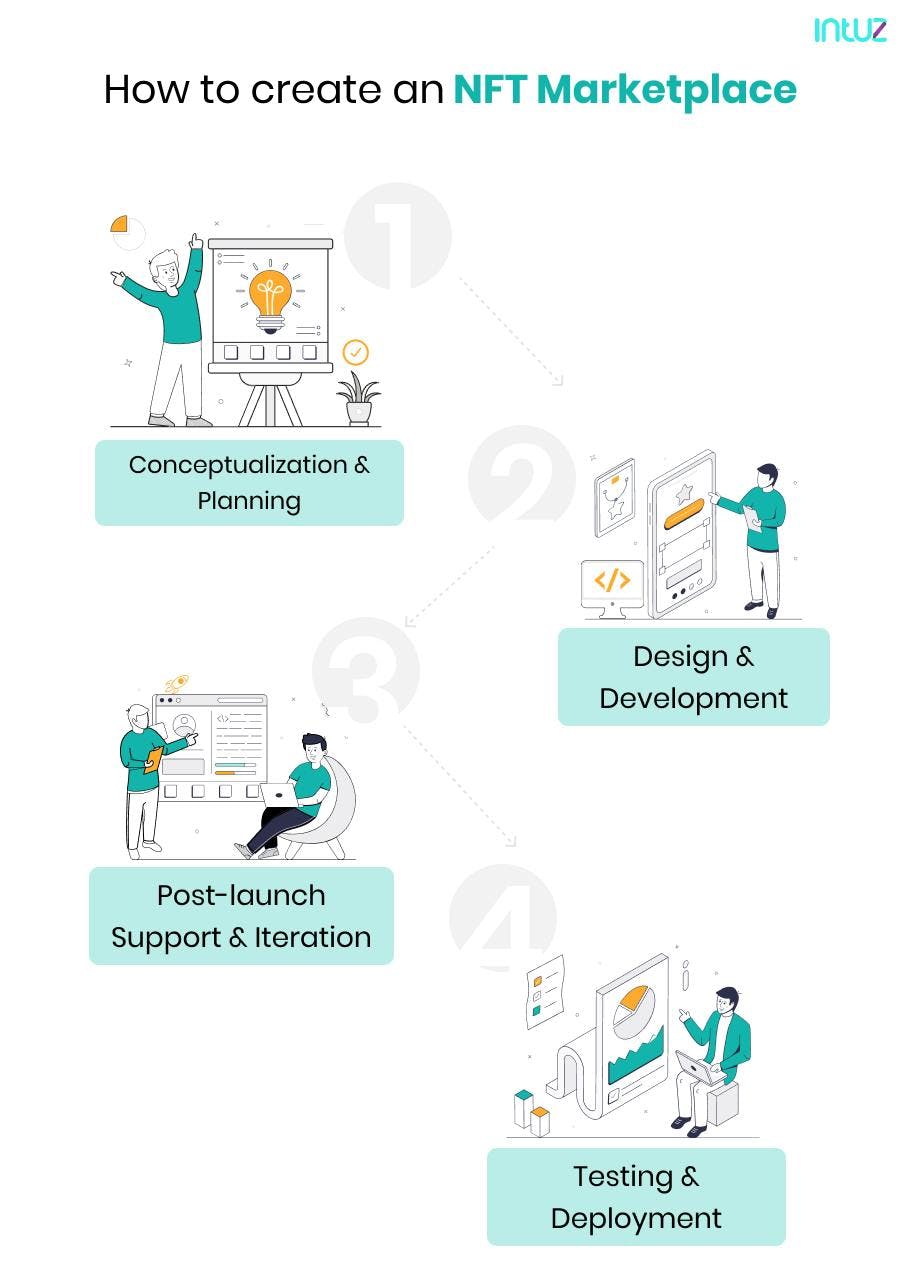
Step 1: Conceptualization and planning
Begin by clearly defining the objectives and goals of your NFT marketplace. Determine if you want to target a specific niche or audience. This clarity will help shape your vision and guide the Marketplace development process. Next:
- Analyze existing NFT marketplaces to understand their features, user experience, and limitations. This research will allow you to identify areas where you can innovate or differentiate your platform, giving you a competitive edge.
- Decide on the core features your NFT marketplace will offer. Consider functionalities such as NFT minting, buying/selling/trading, auctions, royalties, and social features. Prioritize these features based on user needs and market demand.
- Select the appropriate Blockchain network on which your NFT marketplace will operate. While Ethereum is the most popular choice, you can explore alternatives like Binance Smart Chain, Flow, or Polygon. Factors to consider include scalability, transaction fees, community support, and development resources.
Step 2: Design and development
Create visually appealing and user-friendly designs for your NFT marketplace by collaborating with designers and conducting user testing. The goal is to provide a seamless and intuitive experience for your users.
- Implement the front end of your NFT marketplace using popular web technologies such as HTML, CSS, and JavaScript frameworks like React, Angular, or Vue.js. Pay attention to responsive design and optimize performance to ensure a smooth user experience.
- Develop the backend infrastructure that supports the core functionalities of your marketplace. This includes handling user management, NFT metadata storage, transaction management, and integration with the chosen Blockchain. Choose suitable backend technologies like Node.js, Python, or Ruby on Rails.
- Write and deploy smart contracts on your selected Blockchain network. These smart contracts will define the logic for minting, ownership, and transferring NFTs using languages like Solidity or Vyper.
In the end, do not forget to conduct thorough testing and security audits for smart contracts to ensure their reliability, which is crucial.
Step 3: Testing and deployment
Thoroughly test your NFT marketplace across various devices and browsers to ensure its functionality, usability, and security. Conduct manual testing and utilize automated testing tools for efficient and effective testing processes. In addition:
- Perform a comprehensive security audit to identify and address potential vulnerabilities.
- Pay close attention to protecting user wallets, transactions, and sensitive data. Collaborate with external auditors if needed to enhance trust and strengthen security measures.
- Select a reliable hosting provider and deploy your NFT marketplace to a production environment. Set up the necessary server infrastructure, configure domain settings, and implement appropriate caching delivery mechanisms to optimize performance.
Step 4: Post-launch support and iteration
Encourage user feedback and actively listen to your community. Continuously improve your NFT marketplace based on user suggestions and emerging trends. Regularly release updates and bug fixes to enhance the platform’s functionality and user experience. Also:
- Foster a strong and engaged community around your NFT marketplace. Communicate with users through social media, forums, and newsletters. Organize events, collaborations, and artist spotlights to promote user participation.
- Monitor the performance and security of your NFT marketplace on an ongoing basis. Keep track of Blockchain network upgrades and adapt your platform accordingly.
Regularly update dependencies, perform backups, and implement security patches to ensure a smooth and secure user experience.
Thinking of outsourcing NFT marketplace development?
If so, great! Outsourcing involves hiring external teams or individuals to handle your platform’s design, development, and deployment. This approach allows you to leverage specialized expertise and resources while focusing on your core competencies.
However, it also poses challenges that need to be carefully managed. Let us take a look at the advantages, challenges, and best practices associated with outsourcing NFT marketplace development.
Pros
- Outsourcing development to regions with lower labor costs can result in significant cost savings, enabling you to access skilled developers at a fraction of the cost compared to hiring an in-house team.
- Outsourcing provides access to a global talent pool, allowing you to work with developers with specific experience and expertise in NFT marketplace development. This can lead to better-quality outcomes and innovative solutions.
- Because you are leveraging the resources and expertise of dedicated teams, that results in faster development and deployment of the NFT marketplace. This can be crucial in a fast-paced market where being first to market can provide a competitive advantage.
Cons
- Working with a remote team introduces challenges in communication and collaboration. Differences in time zones, language barriers, and cultural nuances may impact the effectiveness of coordination and understanding of project requirements.
- To ensure the quality of outsourced development work, you must establish clear quality standards, provide detailed specifications, and have a robust testing process for launching a marketplace that exceeds expectations.
- Protecting intellectual property rights becomes critical when outsourcing development. You should use legal agreements, non-disclosure agreements, and other measures to safeguard your proprietary information and code.
Best practices
- Clearly define the project scope, functionalities, and technical requirements before engaging with an outsourcing partner. Establish transparent lines of communication and maintain regular updates and feedback loops to ensure effective collaboration.
- Adopt an agile approach emphasizing iterative development, frequent feedback, and flexibility. Keep rigorous testing, code reviews, and regular demos handy to ensure the delivered product meets the desired quality standards.
- Use well-drafted contracts, non-disclosure agreements, and intellectual property protection measures to safeguard your business interests.
NFT Marketplace Solution Using Ethereum and Polygon Ecosystem
View Case StudyWhat to look for in your NFT marketplace development outsourcing company
It is essential to conduct a rigorous selection process to choose a reputable and experienced firm that can help you create a successful and innovative platform in the rapidly evolving world of Blockchain technology. Here are the top things you must check before taking a call:
1. Industry experience
When selecting an outsourcing company, find one with a proven track record in building NFT marketplaces. They should know the functionalities needed for NFT trading, minting, bidding, and ownership verification.
2. Technical expertise
Evaluate the development firm’s technical proficiency in Blockchain platforms, such as Ethereum, Binance Smart Chain, or others relevant to your requirements.
They should be well-versed in smart contract languages like Solidity and possess knowledge of related technologies like IPFS. Assess their ability to handle complex Blockchain integrations and ensure interoperability with different wallets and protocols.
3. Security and compliance
Verify that the outsourcing partner follows security best practices to protect user data, prevent hacks, and ensure the integrity of the marketplace. They should thoroughly understand cybersecurity measures, encryption, and privacy considerations.
Compliance with legal and regulatory frameworks, such as KYC (Know Your Customer) and AML (Anti-Money Laundering) regulations, is also important.
4. Support and maintenance
Inquire about the post-development support provided by the company. They should offer ongoing technical assistance, bug fixes, and regular updates to address any issues arising after the NFT marketplace launch. A reliable support system ensures the long-term success and stability of the platform.
5. Portfolio and references
Review their portfolio to evaluate their previous NFT marketplace projects. Examine the functionality, design, and user experience of their previous work. Additionally, seek client references or testimonials to gain insights into their professionalism, communication skills, and the quality of their work.
6. Adequate team proficiency
In NFT marketplace development, various team members play critical roles in ensuring the success of the project:
- Blockchain developers create smart contracts, integrate the marketplace with Blockchain, and ensure the security and functionality of the NFT marketplace.
- UI/UX designers work on wireframing, prototyping, and designing the user experience to enhance user engagement and satisfaction.
- Project managers oversee the development process, ensuring timely delivery, staying within budget, and meeting client requirements.
- Quality Assurance (QA) professionals identify and fix bugs or issues through comprehensive testing, including functional, performance, and security testing.
- DevOps engineers automate processes, manage servers, monitor performance, and ensure the marketplace is always available and running smoothly.
It is, therefore, essential to ensure the outsourcing partner you choose has a knowledgeable team with relevant hands-on industry experience.
7. Communication and collaboration
They should have clear communication channels and a collaborative approach. They should give regular updates, have transparent discussions, and deliver prompt responses to queries - whenever required.
8. Customizability and scalability
Consider their ability to create a customizable and scalable NFT marketplace. The marketplace should be adaptable to your specific branding and functional requirements. Scalability is crucial for increasing user traffic, handling high transaction volumes, and future expansion.
The future of the NFT marketplace
Now is truly an exciting team to be in the world of NFTs. As an increasing number of individuals and businesses come to trade in NFTs, the future of NFT marketplaces looks promising, with several trends and predictions expected to shape their growth:
- NFT marketplaces are likely to integrate with the metaverse, a VR space where users can interact with each other and digital assets. NFTs can be crucial in the metaverse by representing virtual land, avatars, in-game items, and other digital assets. NFT marketplaces can facilitate the buying, selling, and trading of these virtual assets within the metaverse.
- NFT marketplaces may adopt scaling solutions, such as layer-2 solutions or sidechains, to address scalability challenges and reduce transaction costs. Additionally, there may be a focus on promoting eco-friendly Blockchain networks or exploring alternative consensus mechanisms to reduce the environmental impact of NFT transactions.
- Intellectual property protection is a crucial aspect of the NFT market. Marketplaces may implement improved mechanisms to verify the authenticity and ownership of NFTs, ensuring that artists’ rights are protected. This could involve integrating digital rights management (DRM) solutions or leveraging Blockchain technology to provide transparent ownership records and provenance.
- NFT marketplaces are expected to integrate with decentralized finance (DeFi) protocols, expanding the possibilities for NFT use cases. Through such integration, NFTs can be utilized for collateralized lending, yield farming, and other innovative financial applications. Integrating DeFi will enhance liquidity and automation within NFT transactions, making them more efficient and accessible.
Ready to launch your own NFT marketplace? Contact us today and get started on your custom NFT marketplace development journey!
Explore NowOver to you
The development of NFT marketplaces plays a pivotal role in the flourishing blockchain and crypto sectors. These platforms bridge creators and collectors, providing a secure mechanism for trading digital assets. If you are considering launching your own NFT marketplace, our team of expert developers is prepared to assist. Book a call with our team today.
